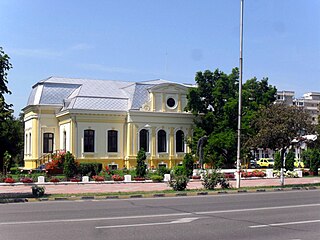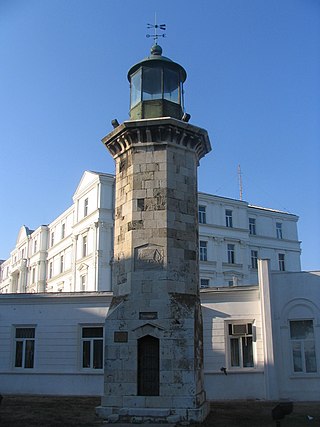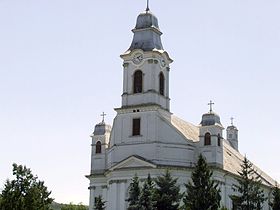
Moldavia is a historical region and former principality in Central and Eastern Europe, corresponding to the territory between the Eastern Carpathians and the Dniester River. An initially independent and later autonomous state, it existed from the 14th century to 1859, when it united with Wallachia as the basis of the modern Romanian state; at various times, Moldavia included the regions of Bessarabia, all of Bukovina and Hertsa. The region of Pokuttya was also part of it for a period of time.

Wallachia or Walachia is a historical and geographical region of modern-day Romania. It is situated north of the Lower Danube and south of the Southern Carpathians. Wallachia was traditionally divided into two sections, Muntenia and Oltenia. Dobruja could sometimes be considered a third section due to its proximity and brief rule over it. Wallachia as a whole is sometimes referred to as Muntenia through identification with the larger of the two traditional sections.

Bacău is the main city in Bacău County, Romania. With a population of 136,087, Bacău is the 14th largest city in Romania. The city is situated in the historical region of Moldavia, at the foothills of the Carpathian Mountains, and on the Bistrița River. The Ghimeș Pass links Bacău to the region of Transylvania.

The culture of Romania is an umbrella term used to encapsulate the ideas, customs and social behaviours of the people of Romania that developed due to the country's distinct geopolitical history and evolution. It is theorized that Romanians and related peoples were formed through the admixture of the descendants of Roman colonists and the indigenous Paleo-Balkanic people who were subsequently Romanized.

Bukovina is a historical region in Eastern Europe. The region is located on the northern slopes of the central Eastern Carpathians and the adjoining plains, today divided between Romania and Ukraine.

Botoșani County is a county (județ) of Romania, in Western Moldavia, with the capital town at Botoșani.

Suceava is a municipality and the namesake county seat town of Suceava County, situated in the historical regions of Bukovina and Moldavia, northeastern Romania and at the crossroads of Central and Eastern Europe respectively. It is the largest urban settlement of Suceava County, with a population of 84,308 inhabitants according to the 2021 Romanian census.

Botoșani is the capital city of Botoșani County, in the northern part of Moldavia, Romania. Today, it is best known as the birthplace of many celebrated Romanians, including Mihai Eminescu, Nicolae Iorga and Grigore Antipa.

The Romanian Greek Catholic Church or Romanian Church United with Rome is a sui iuris Eastern Catholic Church, in full union with the Catholic Church. It has the rank of a Major Archiepiscopal Church and it uses the Byzantine liturgical rite in the Romanian language. It is part of the Major Archiepiscopal Churches of the Catholic Church that are not distinguished with a patriarchal title.

Gherla is a municipality in Cluj County, Romania. It is located 45 kilometres (28 mi) from Cluj-Napoca on the river Someșul Mic, and has a population of 19,873 as of 2021. Three villages are administered by the city: Băița, Hășdate (Szamoshesdát) and Silivaș (Vizszilvás).

The Germans of Romania represent one of the most significant historical ethnic minorities of Romania since the late modern period onwards.

Baia is a commune in Suceava County, in the historical region of Western Moldavia, northeastern Romania with a population of 6,793. It is composed of two villages, namely Baia and Bogata. Located on the Moldova River, it was one of the earliest urban settlements in Moldavia.
The Early Modern Times in Romania started after the death of Michael the Brave, who ruled in a personal union, Wallachia, Transylvania, and Moldavia – three principalities in the lands that now form Romania – for three months, in 1600. The three principalities were subjected to the Ottoman Empire, and paid a yearly tribute to the Ottoman Sultans, but they preserved their internal autonomy. In contrast, Dobruja and the Banat were fully incorporated into the Ottoman Empire.

The Romanian government is the armiger in Romania. It exercises this right under the mandatory advice of the National Committee of Heraldry, Genealogy and Sigillography. The committee is subordinate to the Romanian Academy. All the coats of arms of Romanian institutions must be approved by this committee with two exceptions. The Romanian military is subject to the Ministry of National Defense Heraldric Committee, and Romanian law enforcement institutions are subject to the Ministry of Administration and Interior Heraldric Committee. Both of these committees may share members with the National Committee of Heraldry, Genealogy and Sigillography.

Italian Romanians are Romanian-born citizens who are fully or partially of Italian descent, whose ancestors were Italians who emigrated to Romania during the Italian diaspora, or Italian-born people in Romania.

Armenians in Poland are one of nine legally recognized national minorities in Poland, their historical presence is going back to the Middle Ages. According to the Polish census of 2021 there are 6,772 ethnic Armenians in Poland. They are spread throughout the country, having largely assimilated while preserving a long-standing tradition of settlement.

Romanian Catholics, like Catholics elsewhere, are members of the Catholic Church under the spiritual leadership of the Pope and Curia in Rome. The administration for the local Latin Church is centered in Bucharest, and comprises two archdioceses and four other dioceses. It is the second largest Romanian denomination after the Romanian Orthodox Church, and one of the 18 state-recognized religions. As of 2021, 5.2% of Romanians identified as Catholic. The 2012 census indicated that there were 741,276 Romanian citizens adhering to the Latin Church. Of these, the largest groups were Hungarians, Romanians, Germans and Slovaks.
Freemasonry in Romania traces its origins to the 18th century. Following an intricate history, all organised Freemasonry in the country ceased during the Communist era, although some lodges continued to operate in exile overseas. Freemasonry returned to Romania in the 1990s.

Bulgarians are a recognized minority in Romania, numbering 7,336 according to the 2011 Romanian census, down from 8,025 in 2002. Despite their low census number today, Bulgarians from different confessional and regional backgrounds have had ethnic communities in various regions of Romania, and during the Middle Ages Bulgarian culture has exerted considerable influence on its northern neighbour. According to one Bulgarian estimate, Romanian citizens of Bulgarian origin number around 250,000. According to the Romanian census of 2021, among the 5,975 ethnic Bulgarians, 3,583 were Roman Catholics, 1,977 were Romanian Orthodox and 21 were Serbian Orthodox.

Western Moldavia, also called Romanian Moldavia, or simply just Moldova is the core historic and geographical part of the former Principality of Moldavia situated in eastern and north-eastern Romania. Until its union with Wallachia in 1859, the Principality of Moldavia also included, at various times in its history, the regions of Bessarabia, all of Bukovina, and Hertsa; the larger part of the former is nowadays the independent state of Moldova, while the rest of it, the northern part of Bukovina, and Hertsa form territories of Ukraine.


































